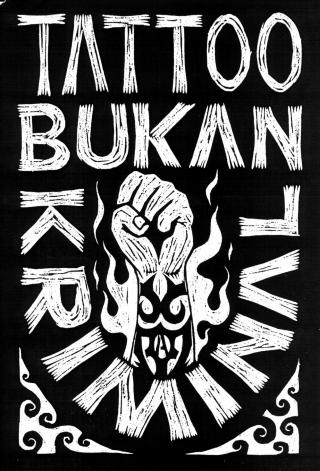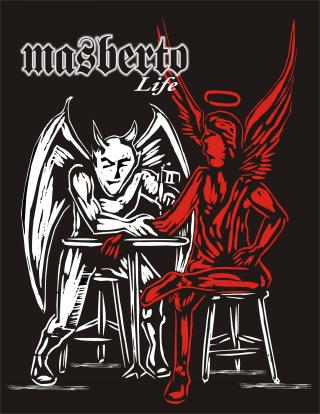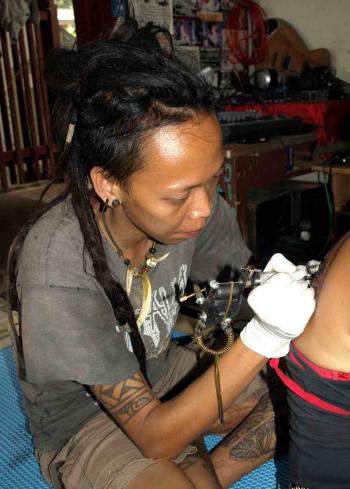Helmi Haska
Bobi of the Marjinal Punk Collective plies his craftIan Wilson |
In 2003 the residents of Kampung Setiabudi in Srengsenawah, Depok got an unexpected shock when a group of scruffy, tattooed punks contracted a house in their neighbourhood. The presence of the punks provoked immediate suspicion. Bobi and Mike caused particular concern. Both are members of the punk band Marjinal and founders of the Taring Babi collective, who for over 10 years have been agitating through art, music and protest on behalf of the Jakarta punk community and those with tattoos.
The punks became the topic of much heated gossip and rumour in the kampung, till one day the neighbourhood head called a meeting. Its goal was to resolve this disruption to the otherwise uneventful life of this community of street vendors and labourers. A consensus was quickly reached that ‘tattooed criminal youths’ were now living in their midst, and that they needed to be kicked out immediately in order to avoid any ‘untoward occurrences’ and to guard the ‘good name’ of the neighbourhood. However, before a vigilante mob set to throw the punkers out, the owner of the contracted house was given an opportunity to state his case.
He was reluctant to evict his new tenants as they had already paid their entire contract in advance. What’s more, finding replacement tenants in a neighbourhood renowned for its flooding and disease-bearing mosquitoes wouldn’t be easy. So the neighbourhood head made a concession, allowing the punks a three-month trial period and requesting that Setiabudi residents keep a close eye on them.
The punks’ relief at this temporary reprieve was short lived, as they realised that they faced a wall of prejudice and preconceptions. They were regularly subjected to comments such as ‘They look like those criminals reported in the newspapers,’ and ‘I think I saw him on Sergap or Patroli!’ referring to popular daily TV crime shows. The attitude towards the punks from the community was one of hostility and rejection. The Marjinal punks were facing a fundamental but all too familiar challenge; how to gain acceptance from the wider community in which they lived. It was hard to negotiate the reality that in the eyes of the residents their tattoos marked them as criminals, warranting not just an open invitation to insult and judge them, but also a phobia that they somehow constituted a threat.
In the eyes of the residents tattoos marked them as criminals
Mike sought a way out of this impasse; ‘We can’t just let this go on without doing something. If we don’t, this will blow out of control and end up consuming all our energy.’ The Marjinal punks had already faced similar bitter experiences. Several times before, they had been refused a house contract due to their appearance and tattoos. However they also accepted that considering the prevailing stereotypes surrounding tattoos, it was understandable that the residents wanted to know exactly who Marjinal were and what they did. The difficulty for the punks was finding an opportunity to show them.
The criminalising of tattoos
According to Mike, ‘The negative stigma we’ve been labelled with didn’t just emerge out of nowhere, but is the result of particular conditions created over time by the political system, the media, and through the use of terror and violence.’ He adds, ‘Remember, in the past there were the so-called mysterious shootings of those with tattoos who were considered criminals and ex-cons.’ Between 1983 and 1984 there was a wide scale massacre of thousands of ostensible ‘criminals’ by the New Order state. Commonly know as the Mysterious Shootings or Petrus (an acronym of Penembakan Misterius), the victims, many of whom were tattooed, were brutally murdered by military officers dressed in civilian clothes. Armed men in jeeps would come to the house of a victim late at night, repeatedly shoot or stab them, and then discard the corpse in the street or river for all to see.
Wearing a tattoo was, and still is for many, to rebel against the taboos and prevailing social norms of ‘straight’ society
At that time, countless tattooed corpses appeared all over the country, and were graphically reported every day in the newspapers. While initially denying involvement in the killings, the government eventually admitted being behind them. The victims were referred to as ‘gali,’ an acronym for ‘gabungan anak liar’: gangs of wild kids. Many of these gali were petty criminals and gang members, a large number of whom had also worked as hired thugs for the government in the 1981 elections before being ‘cut loose’ and returning to the streets.
In his biography, President Suharto stated that the corpses of Petrus victims were deliberately discarded in public as a form of ‘shock therapy’. This ‘therapy’ wasn’t directed solely at so-called criminals, but the whole of Indonesian society. The corpses were left for all to see, Suharto added, ‘in order that everyone understood that in the face of criminality there is someone who can take action and overcome it’. The tattooed corpses of those murdered became a stark reminder of the power of the state. These so-called gangs of wild kids had not faced any court of law; they were labelled criminal and ‘sentenced’ based upon what were perceived as the symbolic markers of criminality inscribed on their bodies. These marks warranted execution despite their bearers not having been convicted of any crime.
 |
Tattoos are not criminal!Marjinal Punk Collective |
Of course not everyone with a tattoo is a criminal. The negative generalisations about tattoos that emerged during this time were products of a politicisation of the body whereby the tattooed skin of the gali was transformed by the state into an instrument of control and used to further legitimate its power. The media played a central role in this dehumanisation of the tattooed gali, with sensationalist reports of anonymous corpses, denying them a voice and individual identities. These conditions created a psychological trauma that deeply affected society’s perception of those with tattoos. As Mike explains, ‘Mainstream society’s perception regarding tattoos was constructed during this time, with the result that tattoos were considered an unmistakable mark of immorality, violence and criminality.’
Opening doors and minds
In order to confront this equation of tattoos with criminality and violence in the mind of the public, the Marjinal collective decided that they had to make themselves ‘transparent’ to the community. They adopted an open house policy and made a habit of doing their screen-printing, linocut prints and other art at the front of the house. As Bobi explained, ‘We let our neighbours see exactly what we were doing. In the beginning they would just sneak a peek over the wall. After a while, some started to come over to take a closer look. We were open and friendly, introducing ourselves, offering coffee and chatting.’ Over the coming months the residents of Kampung Setiabudi discreetly observed the activities of the punkers. Everything they did became the object of discussion, debate and interest. Slowly, the stereotypes were starting to dissolve.
Then one day an opportunity arose for the punks to rub shoulders with the community and gain their trust and respect. The neighbourhood planned to build a bridge over a small river that separated the kampung from the neighbouring kampung of Setu Babakan. After hearing news of the plan, the Marjinal collective held a meeting in which they unanimously decided to participate in the bridge’s construction. As Bobi stated, ‘We realised that this was the perfect moment for us to show that we were not only not criminals, but also productive members of the community committed to its collective welfare.’ Mike told the collective, ‘We have to get out there and help, even if some will accuse us of trying to gain face.’ The punks rubbed shoulders with other kampung youth, mixing cement and carrying building materials while local women prepared coffee, fried tofu and sweet potatoes.
On 11 January 2004 the much-cherished bridge linking the two neighbourhoods was finished. In the process another bridge had been built between the kampung residents and the Marjinal punks. Afterwards, local kids and their parents started to regularly hang out at the Marjinal house, taking part in screen-printing and linocut workshops.
Advocacy through art and music
 |
Masberto: the tattooed community. Through its art and music
|
The Marjinal collective also advocates on behalf of those with tattoos through its art and music. Marjinal has produced numerous posters, screen-prints and linocut prints which address the issue of the stigma attached to tattoos. For example one linocut print shows a tattooed clenched hand surrounded by flames with the slogan ‘Tattoos aren’t criminal!’ T-shirt designs with similar themes can be seen worn by buskers and street kids who hang around the Taman Ismail Marzuki arts centre, a regular haunt of the Marjinal collective. The difficulties facing those with tattoos are also a subject of Marjinal’s lyrics. One Marjinal punk anthem named ‘Masberto,’ an acronym of ‘masyarakat bertato’ (tattooed society), recounts the experience of a youth who is rejected by his potential in-laws due to his tattoos;
Their twisted expressions and words showed they considered him evil,
Not strange to the ears, in fact it’s accepted as culture,
That those with tattoos are criminals or sinners,
Can’t get a job, his girlfriend taken back by her parents,
Because his body is full of coloured ink.
Do tattoos work or take action? No!
Do tattoos kill or wield a weapon? No!
Rotten stereotypes are created by the media,
Via sensational stories short on data,
It’s saddening to think tattoos are considered criminal.
In reality those with tattoos are truly independent,
Expressing creativity through their bodies.
Masberto, we are proud to be tattooed… you have to know!
Masberto, we don’t wear ties and we ain’t thieves... you have to know!
Masberto, the tattooed community are not criminals… you have to know!
Masberto, our bodies may be tattooed but not our hearts… you have to know!
This is our culture…yeoooow!
In reality those with tattoos are truly independent, expressing creativity through their bodies
Before tattoos came to be considered trendy and fashionable amongst the Indonesian urban middle class and elites, as they increasingly are now, tattoos were closely identified with a culture of rebellion and revolt. The negative stereotypes still prevalent in mainstream society, and prohibitions on tattoos in Islam and other religions, has helped to consolidate the image of the tattoo as something forbidden, ‘haram’ and dangerous. Wearing a tattoo was, and still is for many, a way to rebel against the taboos and prevailing social norms of ‘straight’ society. Those who have been marginalised by society continue to get tattooed as a powerful symbol of rebellion and independence. Children who have been outcast or rejected by their families, like the street kids and young punks who flock to the Marjinal house, get tattooed as an indelible mark of their freedom. ii
Helmi Y. Haska (taringbabi@yahoo.com) is a member of the Marjinal Punk Collective based in Srengsengsawah, Depok.
